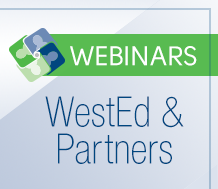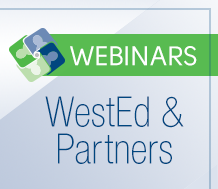Putting Equity at the Center: Q&A with Rose Owens-West
Posted on

Note: The Region IX Equity Assistance Center was based at WestEd from 2011 through 2016. To learn about the four current Equity Assistance Centers, visit the U.S. Department of Education’s Office of Elementary and Secondary Education.
Equity has always been part of the core mission of WestEd, which marks its 50th anniversary in 2016. And the Region IX Equity Assistance Center, currently housed at WestEd, can trace its origins even further back — to the Civil Rights Act of 1964. Begun with a focus on school desegregation, the national network of equity centers has evolved and expanded to embrace the goal of helping educators ensure that all students — regardless of race, gender, or national origin — receive the resources to thrive and succeed academically.
A recent review by an independent, external evaluator gave the Region IX Equity Assistance Center notably high marks, concluding that the center consistently delivered “high quality services that resulted in concrete and valuable changes” at both the local and state levels. As one of ten such centers funded by the U.S. Department of Education’s Office of Elementary and Secondary Education, the Region IX Center serves school districts, schools, and state education agencies in Arizona, California, and Nevada by providing technical assistance and training in civil rights, equity, and school reform.
R&D Alert recently asked Rose Owens-West, who joined WestEd in 1991 and has been the Region IX Equity Assistance Center director since 2011, to talk about what contributes to the effectiveness of the center’s work on equity. Under her direction, the center’s work includes helping school districts tackle issues such as racial disproportionality in program placements and in discipline practices, and boost resources for students traditionally at risk for low achievement. She and her staff also work with state departments of education to develop policies and programs to address issues such as bullying and chronic absenteeism and to improve outcomes for underserved and under-represented students.
Here are excerpts from our conversation with Owens-West about the work of the Region IX Equity Assistance Center at WestEd.
What does the concept of “equity” in education mean to you?
Equity is about opportunity for all, and it means every student gets what he or she needs to succeed academically. Equity is not the same as equality. In some circumstances, ensuring equity means there may not be an equal distribution of resources. For example, some students — such as those eligible for special education services or those who are English learners — may need more.
Unfortunately, efforts to desegregate schools have not achieved equity. Students are still segregated and isolated: by program, by tracking, and by opportunity. . . . For decades, the achievement gap has been the strongest indicator of inequity. There is no reason that certain racial or ethnic groups of students should be performing less well than others.
How does the Equity Assistance Center pursue its mission?
The scope of our work is wide, though every issue we tackle involves an equity focus. Most of our work is defined by responding to clients’ requests. This work has included focusing on eliminating inequitable disciplinary policies and practices; helping schools establish inclusive, culturally responsive climates in which all students can thrive; ending racially based, gender-based, or sexually motivated bullying or harassment; boosting the engagement of families of underserved students; and improving instruction for English learners.
In addition to directly working with clients, we also provide information through publications and online resources. For example, as part of our focus on college and career readiness, we hosted a webinar on early college and middle college high schools. Such schools can promote equity by allowing high school students to take rigorous courses, pursue their interests, and earn college credits with minimal costs to their families.
What do you think makes the center’s efforts to support clients most effective?
When we go into a district, we go as consultants, starting from a point of objectivity by helping school leaders examine data related to equity issues. That process often results in conversations that become emotional and politically charged. The school leaders already know they have a problem; they’re aware of achievement gaps. But we help them by saying, “Here’s a way to talk about the problem.” It shifts the conversation and can help them focus on practical, concrete solutions.
We emphasize bringing about systemic change at the district level. That focus comes, in part, from recognizing that schools are not going to improve in isolation — they must have support from their districts. The responsibility for maintaining a focus on equity falls to the district.
We also focus strongly on implementation and implementation theory, which is critical for sustaining sound practice and obtaining positive outcomes. We help school leaders identify appropriate strategies that can be implemented with fidelity and that can be sustained. Again, we encourage systemwide changes for the long term.
The responsibility for maintaining a focus on equity falls to the district.
Can you point to some examples of the equity center’s work with districts?
Sure. In the Kyrene Elementary School District in Arizona, we are assisting school leaders through our Equity Inquiry process, which involves gathering existing data on achievement, test scores, retentions, promotions . . . and, if necessary, gathering additional data, perhaps by observing in classrooms and interviewing students, teachers, and parents. We are helping Kyrene officials identify, collect, and analyze the data they need to identify and confront the district’s equity issues.
When the San Jose, California, Unified School District was developing the parent engagement section of its District Strategic Plan, we were asked to assist. We worked with the Parent Engagement Task Force to review their existing activities and investigate research-based practices to improve their efforts to reach parents — specifically, parents of English language learners. The Task Force concluded that the district needed to shift its focus to building the capacity of school sites to engage families, rather than using most resources to provide districtwide parent trainings. They changed responsibilities of district staff and changed the name of the district office to reflect the new focus, from “parent education and involvement” to “family engagement.” So we helped the district understand exactly how it needed to engage families and how to update its school improvement plan.
One of our roles when working with the Campbell Union High School District in San Jose, California, was to help the district improve achievement for English language learners. After analyzing their instructional program, we were able to recommend adoption of a districtwide professional development program to support teachers to improve their instructional strategies and, in turn, improve student outcomes.
How do you quantify the center’s impact?
It is difficult to quantify the impact of our work, but doing so is very important so that we can measure our success. Of course, there is an independent evaluation of our work, which found we delivered high-quality services, based on collecting data from our clients. On our part, we look for direct evidence of changes in school policies, improvements in professional development programs, and district strategic plans that include equity as a major focus.
What is a significant challenge facing the center as it seeks to accomplish its mission?
It is challenging to change the culture of schools to take responsibility for the academic outcomes of all students. We know there are special achievement challenges in economically disadvantaged communities, but that must never be an excuse to throw up our hands and say there is little or nothing schools can do. From the moment students enter the schoolhouse door, our job is to educate them to the very best of our ability and, as importantly, with the expectation they will succeed. Our challenge is to do whatever it takes — whatever is possible to do — even in the face of the many challenges students may face outside of school.
What lessons have you learned from your work at WestEd, and specifically at the Equity Assistance Center?
Oh, I’m always learning so much here. The achievement gap is the most consistent indicator of inequities in our education system. And closing the gap requires a focus on equity. I’ve learned that equity should be an intentional focus of every aspect of schooling, which includes ensuring that all children not only feel safe in school but also receive the resources they need to achieve academically, thrive after graduating, and have good success in their lives. At the end of the day, that’s what the equity work is all about.
This work brings me great satisfaction, in part because equity complements and is able to build on all of WestEd’s programs and initiatives, whether around STEM, early childhood education, English language learners, or other areas. It’s wonderful for this work to be so well supported. I feel as if I am in the sweet spot of my career.


